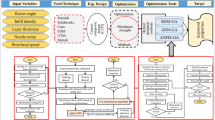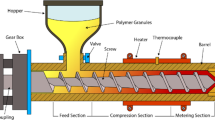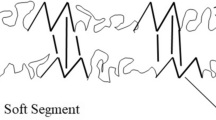Abstract
Fused Filament Fabrication (FFF) technology is popularizing in the world market for prototyping as well as end products of polymeric materials. The mechanical properties and material weight of components created by FFF prominently depend on several process parameters. The earlier studies are generally focused on optimizing FFF process parameters considering the single-objective problem. Investigating mechanical properties and material weight through advanced artificial intelligence-based techniques and multi-criteria decision-making (MCDM) approaches was missing in the literature. This study investigates the mechanical properties and material weight of FFF produced acrylic butadiene styrene (ABS) part. Five process parameters are selected to examine their effect on mechanical strengths and material weight. The fracture modes of specimens loaded to Tinius Olson universal testing machine for mechanical tests are observed through scanning electron microscope (SEM). The mathematical modeling and multi-objective optimization performed through collective use of response surface methodology (RSM), artificial neural network (ANN), multi-objective genetic algorithm (GA) and MCDM approaches. The predicted results through proposed approaches are confirmed through experiments. The prediction error of RSM-GA-MCDM-based approach is 3.61, 3.54 and 1.32%, corresponding to tensile strength, flexural strength and material weight, respectively. Likewise, the prediction error of ANN-GA-MCDM is 6.45, 4.19 and 11.47%, respectively. The outcome of paper shows a significant improvement in mechanical properties with reduced material weight.










Similar content being viewed by others
Abbreviations
- RSM:
-
Response surface methodology
- CCD:
-
Central composite design
- ANOVA:
-
Analysis of variance
- AI:
-
Artificial intelligence
- GA:
-
Genetic algorithm
- ANN:
-
Artificial neural network
- MCDM:
-
Multi-criteria decision making
- TOPSIS:
-
Technique for order of preference by similarity to ideal solution
- FFF:
-
Fused filament fabrication
- RO:
-
Raster orientation (°)
- IF:
-
Infill (%)
- SH:
-
Slice height (mm)
- ET:
-
Extrusion temperature (°C)
- PS:
-
Print speed (mm/s)
- Y :
-
Response parameter
- ɛ :
-
Residual error
- y’:
-
Normalized data for ANN
- r :
-
Row
- c :
-
Column
- u n :
-
Weight linking neurons
- b n :
-
Bias value
- w n :
-
Weight for neuron
- N:
-
Neuron
References
Koester L, Taheri H, Bond LJ et al (2016) Additive manufacturing metrology: state of the art and needs assessment. AIP Conf Proc 1706:1–9. https://doi.org/10.1063/1.4940604
ASTM Standard F2792 12a (2012) Standard terminology for additive manufacturing technologies ASTM International, West Conshohocken, PA. https://doi.org/10.1520/F2792-12A.
Frazier WE (2014) Metal additive manufacturing: a review. J Mater Eng Perform 23:1917–1928. https://doi.org/10.1007/s11665-014-0958-z
Mani M, Lyons KW, Gupta SK (2014) Sustainability characterization for additive manufacturing. J Res Natl Inst Stand Technol 119:419–428. https://doi.org/10.6028/jres.119.016
Wang X, Gong X, Chou K (2015) Review on powder-bed laser additive manufacturing of Inconel 718 parts. J Eng Manuf 231:1–14. https://doi.org/10.1177/0954405415619883
Guo N, Leu MC (2013) Additive manufacturing: technology, applications and research needs. Front Mech Eng 8:215–243. https://doi.org/10.1007/s11465-013-0248-8
Singh S, Ramakrishna S, Singh R (2017) Material issues in additive manufacturing: a review. J Manuf Process 25:185–200. https://doi.org/10.1016/j.jmapro.2016.11.006
Faujiya M (2016) Mechanical and viscoelastic properties of polylactic acid (PLA) materials processed through fused deposition modelling (FDM), Bachelor thesis, School of Engineering, Faculty of Science, Engineering and Technology Swinburne University of Technology Hawthorn, VIC 3122, Australia
Jaisingh Sheoran A, Kumar H (2020) Fused deposition modeling process parameters optimization and effect on mechanical properties and part quality: Review and reflection on present research. Mater Today Proc 21:1659–1672. https://doi.org/10.1016/j.matpr.2019.11.296
Mohan N, Senthil P, Vinodh S, Jayanth N (2017) A review on composite materials and process parameters optimisation for the fused deposition modelling process. Virtual Phys Prototyp 12:47–59. https://doi.org/10.1080/17452759.2016.1274490
Mallesham P (2016) Overview of fused deposition modeling process parameters. In: 2nd National Conference on Developments, Advances & Trends in Engineering Science, pp 92–99
Raney K, Lani E, Kalla DK (2017) Experimental characterization of the tensile strength of ABS parts manufactured by fused deposition modeling process. Mater Today Proc 4:7956–7961. https://doi.org/10.1016/j.matpr.2017.07.132
Srivastava M, Rathee S (2018) Optimisation of FDM process parameters by Taguchi method for imparting customised properties to components. Virtual Phys Prototyp 13:203–210. https://doi.org/10.1080/17452759.2018.1440722
Rathee S, Srivastava M, Maheshwari S, Noor A (2017) Effect of varying spatial orientations on build time requirements for FDM process : a case study. Def Technol 13:92–100. https://doi.org/10.1016/j.dt.2016.11.006
Mohamed OA, Masood SH, Bhowmik JL (2016) Experimental investigations of process parameters influence on rheological behavior and dynamic mechanical properties of FDM manufactured parts. Mater Manuf Process 31:1983–1994. https://doi.org/10.1080/10426914.2015.1127955
Vicente CMS, Leite M (2019) Influence of fused deposition modeling parameters on the mechanical properties of ABS parts. Polym Adv Technol 31:1–7. https://doi.org/10.1002/pat.4787
Sarkar T, Salauddin M, Hazra SK, Chakraborty R (2020) Comparative study of predictability of response surface methodology (RSM) and artificial neural network-particle swarm optimization (ANN-PSO) for total colour difference of pineapple fortified rasgulla processing. Int J Intell Networks 1:17–31. https://doi.org/10.1016/j.ijin.2020.06.001
Dev S, Srivastava R (2020) Experimental investigation and optimization of FDM process parameters for material and mechanical strength. Mater Today Proc 26:1995–1999. https://doi.org/10.1016/j.matpr.2020.02.435
Panda SK, Padhee S, Sood AK, Mahapatra SS (2009) Optimization of Fused Deposition Modelling (FDM) process parameters using bacterial foraging technique. Intell Inf Manag 1:89–97. https://doi.org/10.4236/iim.2009.12014
Ahn S, Montero M, Odell D et al (2002) Anisotropic material properties of fused deposition modeling ABS. Rapid Prototyp J 8:248–257. https://doi.org/10.1108/13552540210441166
Samykano M, Selvamani SK, Kadirgama K et al (2019) Mechanical property of FDM printed ABS: influence of printing parameters. Int J Adv Manuf Technol 102:2779–2796
Huang B, Meng S, He H et al (2018) Study of processing parameters in fused deposition modeling based on mechanical properties of acrylonitrile-butadiene-styrene filament. Polym Eng Sci 59:120–128. https://doi.org/10.1002/pen.24875
Vairis A, Petousis M, Vidakis N, Savvakis K (2016) On the strain rate sensitivity of ABS and ABS Plus fused deposition modeling parts. J Mater Eng Perform 25:3558–3565. https://doi.org/10.1007/s11665-016-2198-x
Uddin MS, Sidek MFR, Faizal MA et al (2017) Evaluating mechanical properties and failure mechanisms of fused deposition modeling acrylonitrile butadiene styrene parts. J Manuf Sci Eng Trans ASME 139:1–12. https://doi.org/10.1115/1.4036713
Durgun I, Ertan R (2014) Experimental investigation of FDM process for improvement of mechanical properties and production cost. Rapid Prototyp J 20:228–235. https://doi.org/10.1108/RPJ-10-2012-0091
Dev S, Srivastava R (2021) Effect of infill parameters on material sustainability and mechanical properties in fused deposition modelling process: a case study. Prog Addit Manuf 6:631–642. https://doi.org/10.1007/s40964-021-00184-4
Yadav DK, Srivastava R, Dev S (2020) Design & fabrication of ABS part by FDM for automobile application. Mater Today Proc 26:2089–2093. https://doi.org/10.1016/j.matpr.2020.02.451
Sun Q, Rizvi GM, Bellehumeur CT, Gu P (2008) Effect of processing conditions on the bonding quality of FDM polymer filaments. Rapid Prototyp J 2:72–80. https://doi.org/10.1108/13552540810862028
Bellehumeur C, Li L, Sun Q, Gu P (2004) Modeling of bond formation between polymer filaments in the fused deposition modeling process. J Manuf Proc 6:170–178. https://doi.org/10.1016/S1526-6125(04)70071-7
Deshwal S, Kumar A, Chhabra D (2020) Exercising hybrid statistical tools GA-RSM, GA-ANN and GA-ANFIS to optimize FDM process parameters for tensile strength improvement. CIRP J Manuf Sci Technol 31:189–199. https://doi.org/10.1016/j.cirpj.2020.05.009
Savvakis K, Petousis M, Vairis A, Vidakis N, Bikmeyev A (2014) Experimental determination of the tensile strength of fused deposition modeling parts. ASME 2014 Int Mech Eng Congr Expo 14:V014T11A022
Ziemian S, Okwara M, Ziemian CW (2015) Tensile and fatigue behavior of layered acrylonitrile butadiene styrene. Rapid Prototyp J 21:270–278. https://doi.org/10.1108/RPJ-09-2013-0086
Taufik M, Jain PK (2013) Role of build orientation in layered manufacturing: a review. Int J Manuf Technol Manag 27:47–73
Zhang Y, Bernard A, Harik R, Karunakaran KP (2017) Build orientation optimization for multi-part production in additive manufacturing. J Intell Manuf 28:1393–1407. https://doi.org/10.1007/s10845-015-1057-121
Liu J, Gaynor AT, Chen S et al (2018) Current and future trends in topology optimization for additive manufacturing. Struct Multidiscip Optim 57(6):2457–2483. https://doi.org/10.1007/s00158-018-1994-3
Paul R, Anand S (2014) Optimization of layered manufacturing process for reducing form errors with minimal support structures. J Manuf Syst 36:231–243. https://doi.org/10.1016/j.jmsy.2014.06.014
Xu F, Loh HT, Wong YS (1999) Considerations and selection of optimal orientation for different rapid prototyping systems. Rapid Prototyp J 5:54–60. https://doi.org/10.1108/13552549910267344
Song R, Clemon L, Telenko C (2018) Uncertainty and variability of energy and material use by fused deposition modeling printers in makerspaces. J Ind Ecol 23:699–708. https://doi.org/10.1111/jiec.12772
Byun HS, Lee KH (2005) Determination of the optimal part orientation in layered manufacturing using a genetic algorithm. Int J Prod Res 43:2709–2724. https://doi.org/10.1080/00207540500031857
Tymrak BM, Kreiger M, Pearce JM (2014) Mechanical properties of components fabricated with open-source 3-D printers under realistic environmental conditions. Mater Des 58:242–246. https://doi.org/10.1016/j.matdes.2014.02.038
Harris M, Potgieter J, Ray S, Archer R (2019) Preparation and characterization of thermally stable ABS/HDPE blend for fused filament fabrication. Mater Manuf Process 35:230–240. https://doi.org/10.1080/10426914.2019.1692355
Montgomery DCASU (2017) Design and analysis of experiments, 9th edn. John Wiley & Sons Inc, New Jersey
Gupta SK, Pandey KN, Kumar R (2018) Artificial intelligence-based modelling and multi-objective optimization of friction stir welding of dissimilar AA5083-O and AA6063-T6 aluminium alloys. Proc IMechE Part L J Mater Des Appl 232:333–342. https://doi.org/10.1177/1464420715627293
Konak A, Coit DW, Smith AE (2006) Multi-objective optimization using genetic algorithms: A tutorial. Reliab Eng Syst Saf 91:992–1007. https://doi.org/10.1016/j.ress.2005.11.018
Kim K (2014) Business information system recovery priority decision using TOPSIS on interval data. J Syst Inf Technol 16:103–112. https://doi.org/10.1108/JSIT-12-2013-0068
Garg A, Bhattacharya A, Batish A (2017) Failure investigation of fused deposition modelling parts fabricated at different raster angles under tensile and flexural loading. Proc Inst Mech Eng Part B J Eng Manuf 231:2031–2039. https://doi.org/10.1177/0954405415617447
Nidagundi VB, Keshavamurthy R, Prakash CPS (2015) Studies on parametric optimization for fused deposition modelling process. Mater Today Proc 2:1691–1699. https://doi.org/10.1016/j.matpr.2015.07.097
Dong G, Wijaya G, Tang Y, Zhao YF (2018) Optimizing process parameters of fused deposition modeling by Taguchi method for the fabrication of lattice structures. Addit Manuf 19:62–72. https://doi.org/10.1016/j.addma.2017.11.004
Asadollahi-yazdi E, Gardan J, Lafon P (2018) Toward integrated design of additive manufacturing through a process development model and multi-objective optimization. Int J Adv Manuf Technol 96:4145–4164. https://doi.org/10.1007/s00170-018-1880-6
Acknowledgements
We are grateful to the Director MNNIT Allahabad, Prayagraj, Uttar Pradesh, India for providing necessary laboratory facilities. The Ministry of Education, Govt. of India, New Delhi, India, is acknowledged for providing financial assistance to Saty Dev throughout this tenure.
Funding
This research did not obtain any grant from funding agencies in the commercial, public, or not-for-profit divisions.
Author information
Authors and Affiliations
Contributions
Rajeev Srivastava: Designed the study and guided to perform experiments; Saty Dev: Performed the experiments, analysed the results, Writing- original draft preparation; All authors read and commented on the manuscript.
Corresponding author
Ethics declarations
Conflict of interest
The authors declare that they have no conflict of interest.
Additional information
Publisher’s Note
Springer Nature remains neutral with regard to jurisdictional claims in published maps and institutional affiliations.
Rights and permissions
About this article
Cite this article
Dev, S., Srivastava, R. Influence of process variables on mechanical properties and material weight of acrylic butadiene styrene parts produced by fused filament fabrication. Prog Addit Manuf 8, 143–158 (2023). https://doi.org/10.1007/s40964-022-00318-2
Received:
Accepted:
Published:
Issue Date:
DOI: https://doi.org/10.1007/s40964-022-00318-2




